|
|
|
After mounting the MZ34, I discovered that neither the IVO Ultralight or Medium propellers gave optimal performance. When using the Ultralight, one could get the engine up to 6,200 rpm and 27 hp, but the pitch was too low and FireFly cruise was 40 mphi. After cutting the Ultralight and boosting the pitch, performance was still dismal. The Medium IVO over propped the engine so that the FireFly would cruise 55 mphi at 5,600 rpm using 23.6 hp. After shortening the propeller and setting minimum pitch, the best performance was about equal speed indicated with the engine turning, 5,800 rpm and 25 hp. It seemed the only way to gather up the last two horsepower and to retain a good cruise speed would be to purchase a new propeller. But after pricing propellers, I thought that a change in the belt reduction unit from 2.34 to 2.6 could produce good results with the present Medium IVO propeller.
|
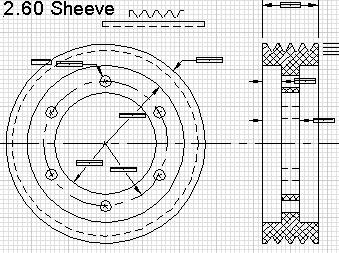 To obtain a larger belt ratio and to achieve the largest belt wrap on the smaller driving sheave, it is important to use the longest belt possible. Fortunately, Gates supplies these belts with 15mm incremental changes in length.
To obtain a larger belt ratio and to achieve the largest belt wrap on the smaller driving sheave, it is important to use the longest belt possible. Fortunately, Gates supplies these belts with 15mm incremental changes in length.
Sheave profile data was found on the Gates website. |
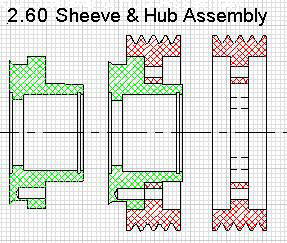
By thinning the flange just below the belt slot profiles, additional weight could be saved. This thickness was preserved to allow, if necessary, a reduction in belt ratio. The original unmodified hub weighed one pound 13.6 ounces. |
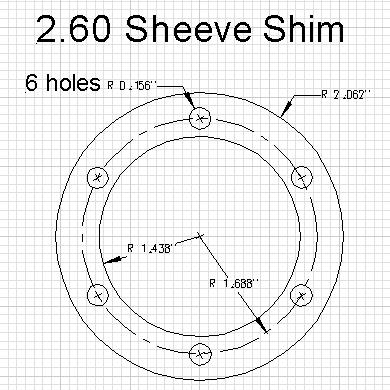 To tighten the belt the eccentric
screws in to the reducer mount on something close to 20 threads per inch. This means that it is possible to have to have as much as 0.050 of an inch misalignment between the driving and driven pulleys. To compensate for this one can place shims between the hub and sheave to bring the pulleys into very good alignment. Due to the change in belt path length a slightly larger 4/7M560JB belt was used rather than two 2/7M530JB belts.
To tighten the belt the eccentric
screws in to the reducer mount on something close to 20 threads per inch. This means that it is possible to have to have as much as 0.050 of an inch misalignment between the driving and driven pulleys. To compensate for this one can place shims between the hub and sheave to bring the pulleys into very good alignment. Due to the change in belt path length a slightly larger 4/7M560JB belt was used rather than two 2/7M530JB belts.
|
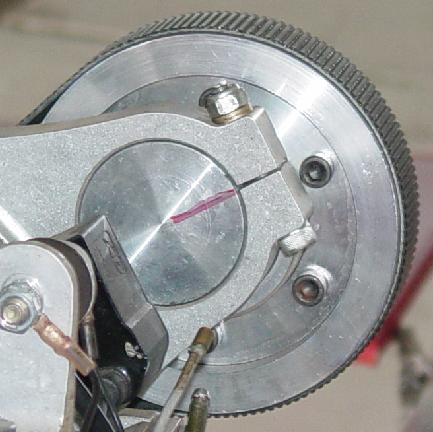 And here is the end product. The combined weight of the modified hub and sheave plus six bolts is two pounds 11.6 ounces. This is a weight gain of 11.0 ounces over the original hub and sheave.
And here is the end product. The combined weight of the modified hub and sheave plus six bolts is two pounds 11.6 ounces. This is a weight gain of 11.0 ounces over the original hub and sheave.
Performance testing will have to wait for warmer weather. |
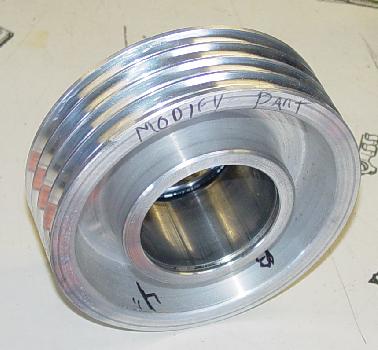 So that it could be measured for modification, the propeller hub and sheave was removed from the spindle. The original sheaves will be removed down to 4.250 inch OD, and the closest outer edge removed to the solid circular web. This leaves a hub that contains the original propeller face and bolt hole circle. To this a slip over sheave can be bolted to the exposed circular web which will accommodate any desired belt ratio.
So that it could be measured for modification, the propeller hub and sheave was removed from the spindle. The original sheaves will be removed down to 4.250 inch OD, and the closest outer edge removed to the solid circular web. This leaves a hub that contains the original propeller face and bolt hole circle. To this a slip over sheave can be bolted to the exposed circular web which will accommodate any desired belt ratio.
